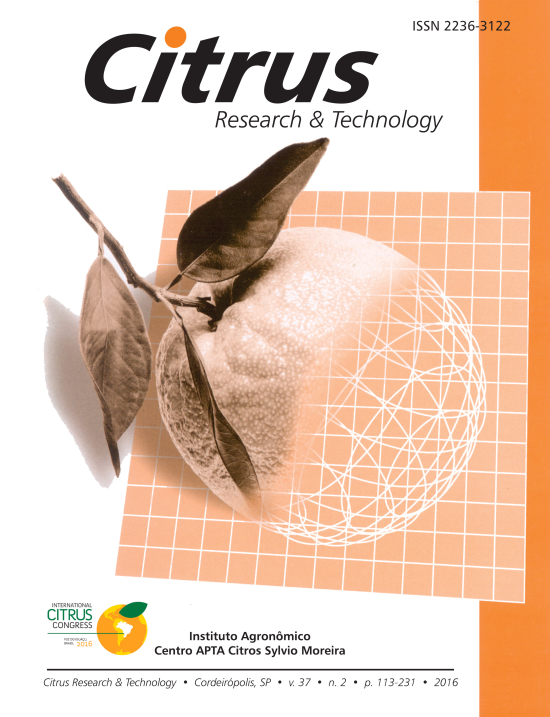CONTROLE QUÍMICO DE Colletotrichum acutatum EM LARANJA DOCE BARÃO
Chemical control of Colletotrichum acutatum in sweet orange
Fernando Alves de Azevedo, Evandro Henrique Schinor, Katia Cristina Kupper, Marinês Bastianel & Marcos Paulo Rossetto
Resumo
O ensaio foi realizado na fazenda Santa Rosália, município de Araras (SP), na florada de 2006/2007, visando avaliar a eficiência agronômica de diferentes fungicidas no controle da podridão floral dos citros causada por Colletotrichum acutatum. Utilizou-se a variedade cítrica laranja doce Barão, com 11 anos de idade, plantada em espaçamento 7 x 4 m. O delineamento experimental foi de blocos casualizados com seis tratamentos, quatro repetições e 12 plantas por parcela, sendo a parcela útil constituída pelas duas árvores centrais de cada tratamento. Avaliaram-se os tratamentos seguintes: 1) famoxadona + mancozeb (96g/100L); 2) folpet (200g/100L); 3) carbendazim (50mL/100L); 4) (famoxadona + mancozeb) + carbendazim (48g + 50mL/100L); 5) folpet + carbendazim (200g + 50mL/100L); 6) testemunha. Realizaram-se duas aplicações com intervalo de sete dias. Logo após a segunda aplicação, avaliou-se a porcentagem de flores com sintoma da doença. Realizaram-se, também, duas determinações do número de frutos fixados por metro quadrado de copa, sendo aos 48 e 90 dias após a última pulverização. Aos 90 dias, determinou-se, ainda, o número de cálices ("estrelinhas") por metro quadrado. Nas condições do ensaio, todos os tratamentos reduziram a porcentagem de flores com sintomas da doença; naqueles que se utilizou o carbendazim houve melhor controle de Colletotrichum acutatum e maior número de frutos fixados/m2 ; nenhum fungicida, na dose aplicada, proporcionou fitotoxicidade à cultura.
Palavras-chave
Abstract
The research was held at Santa Rosália farm, located in Araras (state of São Paulo), during the 2006/2007 blooming season, aiming the comparison of several fungicides in the control of post bloom fruit drop caused by Colletotrichum acutatum. The citrus variety used was sweet orange cv. Barão, from an eleven-year-old orchard planted in a 7 x 4m spacing. A randomized experimental block was used with six treatments, four replications and 12 trees per plot, that is, the assessed plot was made up of two central trees of each treatment. The treatments evaluated were: 1) famoxadona + mancozeb (96g/100L); 2) folpet (200g/100L); 3) carbendazim (50mL/100L); 4) (famoxadona + mancozeb) + carbendazim (48g + 50 mL/100L); 5) folpet + carbendazim (200g + 50 mL/100L); 6) check. Two sprayings were applied with a 7-day interval. Right after the second application, the percentage of flowers with disease symptoms was determined. At the 48th and 90th days after the last spraying, the number of fruits in a square meter of canopy was determined. In the 90th day, the number of calyxes per square meter was also determined. Our data showed that all treatments resulted in the reduction of the percentage of symptomatic flowers, particularly carbendazim, which presented the best control of post bloom fruit drop and the highest number of fruits per square meter. None of the fungicides caused toxicity to the crop in the dosages used.

